
Theodore Johnson, chief probation officer, Western District of Pennsylvania.
2009 AO Director's Awards
Outstanding Leadership
Theodore Johnson, chief probation officer, Western District of Pennsylvania. During a period of growth and change in his office, Johnson initiated a workforce development program that has benefited offenders and ex-offenders; participants in the program have a very low recidivism rate. Johnson also has incorporated an offender risk hierarchy into supervision practices to focus resources on areas of greatest need. His efforts to conserve and improve Judiciary resources have included establishing an active internship program. Interns contribute and develop valuable skills while the office benefits from their contribution.
Excellence in Court Operations (Mission Requirements)

Sarah Pfeiler, pretrial services officer, U.S. District Court, Northern District of Ohio.
Sarah Pfeiler, pretrial services officer, U.S. District Court, Northern District of Ohio. Pfeiler developed Project Penalty Awareness to raise understanding throughout her community about federal penalties for drug-related crimes. Target audiences are juveniles, gang members, and drug users. The Cleveland Public Schools have adopted the program as part of the eighth grade social studies curriculum. Her work on this program has enhanced the public’s image of the Judiciary.

Wendy Landry, supervisory probation officer, Northern District of Texas.
Wendy Landry, supervisory probation officer, Northern District of Texas. Landry implemented a mobile office program that increased accessibility to officers and the community, and resulted in cost savings for the Judiciary. The program has improved services to clients and contributed to flexible and productive work arrangements for officers.
Extraordinary Actions
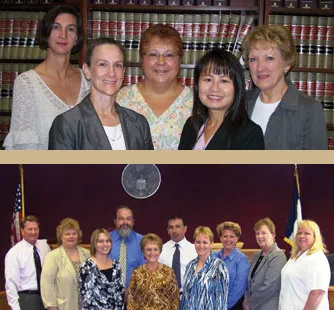
The Bankruptcy Clerk’s Office, Northern District of Iowa: Nicole Becker, Kent Boese, Ruth Dean, Rhonda Hansen, Becky Hoefer, Nancy South, and Theresa Stapelman, case administrators; Shane Deam, programmer/analyst; Som Many Greigg and Julie Hubbell, courtroom deputies; Tina Hall, operations supervisor; Karen Hanover, CM/ECF administrator; Jean Hekel, chief deputy clerk; Tim Mielke, automation specialist; and Sharon Mullin, financial administrator.
The team was commended for their efforts in successfully activating their court continuity of operations plan (COOP) during the 2008 flood that devastated their community. They were recognized for outstanding communication efforts with the AO and other organizations, as well as for their concern for others who work in their facility. They were commended for their efforts to resume essential court functions in service to the public within 24 hours of activating their COOP.
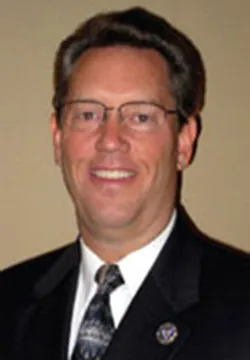
Robert L. Phelps, clerk of court, U.S. District Court, Northern District of Iowa.
Robert L. Phelps, clerk of court, U.S. District Court, Northern District of Iowa. Phelps’ court management staff nominated him for his exceptional efforts during the 2008 flood. He was recognized for managing an extensive logistical operation to keep court employees safe while continuing court operations during the natural disaster. He has shared lessons learned through presentations at Judiciary meetings and conferences.
2009 Award for Exemplary Service to the Courts
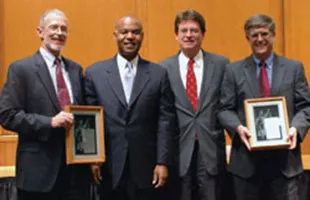
Winners of the Leonidas Ralph Mecham Award: James Wannamaker, Bankruptcy Judges Division, and Neal Dillard, Infrastructure Management Division.
Four years ago, the Judicial Conference Committee on the Administrative Office instituted the Leonidas Ralph Mecham Award to recognize AO employees for significant accomplishment on a specific project or effort that has improved court administration, internal controls, program effectiveness, communications, or efficiency in the courts or the AO. The winners of this year’s awards were James Wannamaker, Bankruptcy Judges Division, and Neal Dillard, Infrastructure Management Division. The Committee selected Wannamaker because of his extraordinary efforts assisting the Bankruptcy Rules Advisory Committee and the entire bankruptcy system in implementing the Bankruptcy Abuse Prevention and Consumer Protection Act. Dillard was recognized for his work developing and deploying four major components of the Judiciary’s telecommunications networks, including the Data Communications Network (DCN), public access network (PACERNet), local area networks (LANs), and two Internet gateways.
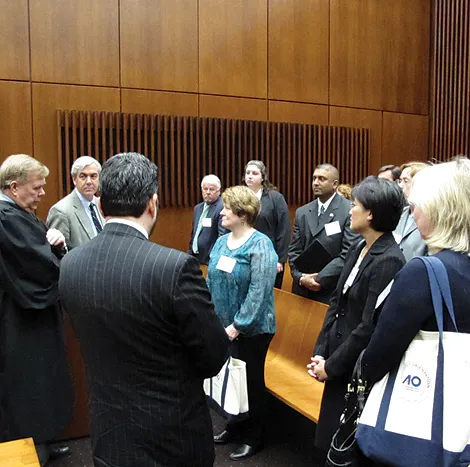
Four distinct exchange programs were launched under the Court-AO Exchange Program during fiscal year 2009. The program builds on effective partnerships between the courts, federal defender organizations, and the AO, strengthening the Judiciary’s ability to address major challenges as a united team.
The Year of Employee Empowerment
Collaboration between the AO and courts was the theme for three FY 2009 technology initiatives that changed how employees manage their personal and payroll information. The initiatives, applications within the Judiciary’s centrally managed Human Resources Management Information System (HRMIS), are driven by court needs and priorities. Courts participated in needs analysis, application requirements definition, and implementation planning through the Human Resource Specialist Advisory Group and HRMIS User Panel. After development, court HR staffs assisted in end user testing, application piloting, and implementation to court employees throughout the nation.
Overall, the key benefits delivered with these technology initiatives included direct and indirect cost savings, direct online access to employee information, and reduced court HR staff transaction paper processing. Court HR staffs now have more time for strategic HR activities such as recruitment and workforce planning. Additionally, these collaborative initiatives position the Judiciary for future cost savings or avoidance, efficiency improvement opportunities, and enhanced management decision making in FY2010 and FY2011. Briefly, the technology initiatives are:
eService
eService empowers the 33,000 Judiciary employees to view their personal information and payroll earnings statements online and to make changes without the need for HR staff to process paper. These changes include name and address, direct deposits, allotments and W-4 updates. As a result, the cost of biweekly and monthly printing, mailing and distribution of many paper products is eliminated.
eOP
eOP enables employees to view and print online documents from their Official Personnel Folder 24 hours/day. OPFs are now updated within days instead of months, staff no longer need to copy and file tens of thousands of paper documents, and the system is highly secure. Implementing in partnership with the Office of Personnel Management, the Judiciary will garner further savings through major reductions in filing and distribution of paper products, now transmitted, stored, and viewed electronically.
Leave Tracking
Thirty courts now use this HRMIS application, a primary alternative to existing leave and time management systems maintained on court servers. Leave requests and work time are tracked and approved online and employees see their leave balances on their biweekly earnings statements. By using this centrally maintained application, courts save on maintenance and other costs. Additionally, administrative audits are easier for courts that use Leave Tracking. A multi-year implementation strategy is in place that will allow additional courts to adopt Leave Tracking in the future.
eBenefits on the Judiciary Benefits Center
In October 2009, online self-service enrollment for health insurance became available for judges and Judiciary employees. Self-service enrollment for life insurance became available in May 2009, and self-service for the Thrift Savings Plan will become available in 2010.
These services are available on the Judiciary Benefits Center, an online, confidential, one-stop resource for information and tools regarding the Judiciary’s benefit programs. The Judiciary Benefits Center was launched in 2008 as an expansion of the self-service website offered for many years by SHPS, the third party administrator of the Judiciary’s flexible benefit and commuter benefit programs.
eBenefits streamlines benefits enrollment and administration, eliminates unnecessary paperwork, and empowers judges and employees to manage their benefits directly. Self-service has proven its value in other Judiciary benefits programs that are already online.
Nearly 13,000 judges and employees enrolled in health care accounts and dependent care accounts for the 2009 Flexible Benefit Program plan year. This marks the tenth straight year of increased enrollments since the program began in 2000.
Enrollments in the Federal Employees Dental and Vision Insurance Program for the 2009 coverage year total 17,836, which is a 25 percent increase over 2008 levels. Enrollments in 2008 increased 28 percent from 2007, which was the first year of the program’s operation.
There were nearly 1,700 new applications for coverage during the final open enrollment for the Federal Judiciary Group Long-Term Care Insurance Program held last summer. This increased the number of participants by 30 percent, to 7,518.
Performance Management
Human resources staff provided advice and assistance to courts as they developed plans to implement the performance management guidelines that were approved by the Judicial Conference in September 2008. The plans will support the discretionary granting of step increases to Court Personnel System employees beginning in October 2010. Staff also supported a working group of court unit executives in the development and delivery of training on the Judicial Conference-approved performance management guidelines.
Court Personnel System Benchmarks
In January 2009, the revised Court Personnel System benchmarks, which were developed with the participation of a court unit executive working group, went into effect. Human resources staff supported the implementation through the posting of a set of frequently asked questions, the incorporation of the benchmarks into an HR Academy module on classification, and the delivery of training to court unit executives in October 2008. The revised benchmarks are intended to achieve a cost savings of $52 million through fiscal year 2017.
Human Resources Academy

The HR Academy gives human resources managers hands-on training in Judiciary personnel practices and prepares them to support and develop the court workforce.
In August, two sessions of the HR Academy were conducted by AO and court faculty. The HR Academy, which was developed in collaboration with the Human Resources Specialist Advisory Group, provided in-person training for HR specialists. The training focused on hands-on practical skill development. Twelve hours of online training was required as a perquisite. A total of 98 HR professionals with less than three years of experience attended.
Human Resources Initiatives at the AO
The Director appointed a Human Resources Working Group to provide advice and recommendations on human resource policies, practices, and programs of importance to all AO employees. The group’s formation was a result of input from an ad hoc court advisory group and internal AO planning teams that developed strategies to implement the advisory group’s recommendations. In the last year, based on the HR Working Group’s recommendations, an AO Internal Exchange Program and the use of staffing plans to speed up the recruitment process have been implemented, and planning for an AO Mentoring Program and a new performance management system are well underway.
Benefits and Retirement Programs for Judges
During FY 2009, 25 benefits and retirement programs were held for over 300 judges and their spouses. These programs provide information to judges new to the Judiciary, in mid-career, and those approaching retirement. This year, programs were conducted at New Judge Orientations sponsored by the FJC. Programs were conducted at FJC Circuit Workshops, Circuit Judicial Conferences, judge retreats, and at several individual courts. The retirement planning programs are offered to judges who are within a few years of retirement eligibility. The agenda includes information on health, life, dental and vision insurance, the flexible benefits program, long-term care insurance, Thrift Savings Plan, and the Judicial Survivors’ Annuities System. Retirement information is provided on senior and recall status, full retirement from the Article III bench, the Judicial Retirement Systems, the Federal Employees Retirement System, and the Civil Service Retirement System, in addition to Social Security benefits and Medicare.
Work Measurement
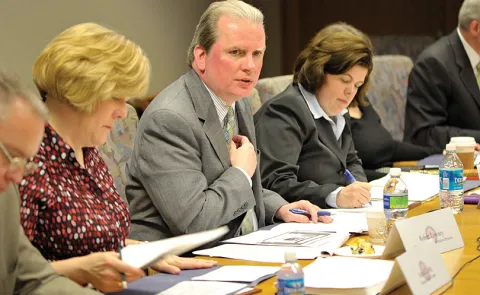
At one work session held during the year, court unit executives and AO staff brainstormed about partnership activities to support court administration needs at the local level.
The Judicial Conference, at its September 2009 session, endorsed the process of developing full staff requirements through consensus-developed, empirically derived, and transparently coordinated work measurement formulas. As a result of the endorsed process, the Conference approved staffing formulas for appellate clerks, bankruptcy appellate panel clerks, staff attorneys, district clerks’ offices, pro se law clerks, and the bankruptcy administrator program for implementation in fiscal year 2010. Teams of court experts built work center descriptions with assistance from the Administrative Office (AO). The Judicial Resources Committee’s work measurement subcommittee oversaw all work measurement issues, increasing judge involvement and influence in the process.
Online System for Clerkship Application and Review
In February 2009, the Online System for Clerkship Application and Review (OSCAR) Program seamlessly transferred from the U.S. District Court for the District of Columbia to the Administrative Office. The effort involved transferring the program assets and staff, setting up a new help desk ticketing system and telephone lines, and integrating the OSCAR informational website that was maintained by the district court into the current OSCAR system. OSCAR participation significantly grew to 1,440 judges using the system to maintain a judge profile, post their clerkship positions, and accept electronic applications.
Annual Report 2009
- Annual Report 2009
- Legislative Activity
- Direct Impact On The Public
- Judges Programs
- Facilities, Security, and Emergency Planning
- Business Improvements, Studies, and Activities
- Key Studies and Activities
- Human Resources
- Technology
- Probation and Pretrial Services
- Defender Services
- Communications
- In Profile
- A Strategic Direction For The Administrative Office of the United States Courts, Fiscal Years 2009–2013
